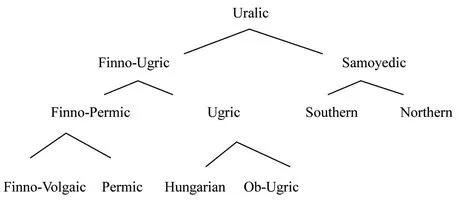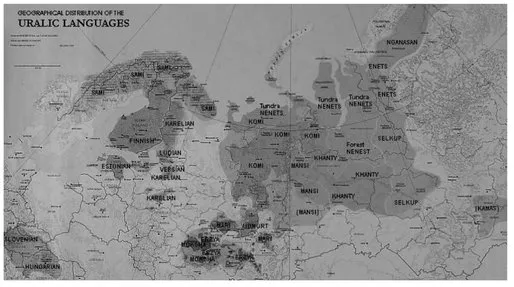1 Tundra Nenets language
The self-designation of the Tundra Nenets is n′enec′°h ‘Nenets; person’, etymologically related to the word n′eney° ‘true’. The older name for the Nenets used in 19th and early 20th century Russian-language literature, as well as in European languages, is Yurak-Samoyeds or simply Yuraks. The word ‘Yurak’ originates from Komi Zyryan and may be related to the family name Yar in widespread use on the Yamal peninsula.
1.1 Genetic affiliation
Tundra Nenets belongs to the Samoyedic group of the Uralic language family. The main branches of the family are schematically represented below according to traditional classifications (see e.g. Abondolo 1998):
Apart from Tundra Nenets, the Samoyedic group includes Forest Nenets, Tundra Enets, Forest Enets, and Nganasan (these are usually classified as Northern Samoyedic languages), as well as the only living representative of the Southern Samoyedic subgroup, Selkup, which consists of several dialects. Other Southern Samoyedic languages, Kamassian, Mator and Koibal are now extinct, with the last speaker of
Kamassian having died in 1989. Tundra Nenets is presently the largest and the most well-preserved Samoyedic language. The geographical distribution of the Uralic languages is shown below (map created by the Finno-Ugric Society, Helsinki).
The closest linguistic relative of Tundra Nenets is Forest Nenets spoken around the Agan, Lyamin, Pur and Nadym rivers in the Yamalo-Nenets Autonomous District of Russia. The two Nenets languages have long been considered as dialects and are still classified as such by e.g. Ethnologue (http://www.ethnologue.com/show_language.asp?code=yrk ) and most Russian-language sources. However, linguistic differences between them are rather significant; they are comparable to those that exist between German and Dutch (Salminen 1993–2012), and mutual comprehension is almost impossible. Therefore many modern authors view Tundra Nenets and Forest Nenets as separate albeit closely related languages and talk about ‘the Nenets subbranch of Samoyedic’, which includes two languages, rather than the single ‘Nenets language’ (see, e.g., Salminen 1997; Helimskij 2002; Toulouze 2003; Ackerman and Salminen 2006; Salminen 1993–2012). The most up-to-date source on Forest Nenets morphosyntax is Koshkarëva (2005) and on Forest Nenets phonology see Salminen (2007). Historically there was another variety of Nenets spoken in the area between the mouths of the Taz and Enisej rivers until the mid 19th century (Helimskij 2000).
1.2 Geographical location
In the first centuries of the first millennium AD the ancestors of the Northern Samoyeds split from the Southern Samoyedic subgroup and migrated into the polar regions, where they are likely to have assimilated the native Arctic population which was autochthonous in that area. They spread further over the vast territory of the Arctic part of European Russia and North-Western Siberia, with the Tundra Nenets being the largest and most dominant group there. The native land of the Tundra Nenets is the tundra zone adjacent to the Arctic Ocean and some islands in the ocean, while along the course of the river Ob it also reaches the taiga forest area. Their traditional economy has always been based on hunting and reindeer herding in this area. Using reindeer as a draft animal made the Nenets very mobile and allowed them to cover great distances.
Administratively the Tundra Nenets territory presently includes the whole Nenets District of the Arkhangelsk Province, parts of the northernmost regions in the Komi Republic, several regions of the Yamal-Nenets District in the Tyumen Province, and most of the Ust-Yeniseisk region of the Taimyr District in the Krasnoyarsk Region. The most western territory of the Tundra Nenets is the Kanin Peninsula and the tundra of the Malaya Zemlya. In the east the Tundra Nenets area reaches the Yamal peninsula, the delta of the Yenisei river and Yenisei Bay, while the southern boundary of their territory extends just beyond the tree line.
The territory of the Tundra Nenets is adjacent to the areas where other languages of the Uralic language family are spoken. These include Northern Mansi (spoken in the area of the Northern Ural mountains), Komi (spoken across most of the European side of the Urals) and Northern Khanty (spoken in the Ob area). These languages have had extensive contact with Tundra Nenets for a very long time. Tundra Nenets has also been in close contact with all other Samoyedic languages, namely, Forest and Tundra Enets on the Taimyr peninsula, Forest Nenets in the Nadym and Pur areas, Northern varieties of Selkup along the river Taz, and Nganasan in the far eastern part of the Tundra Nenets territory. Non-Uralic languages which have been in contact with Tundra Nenets are Evenki (Tungusic), Ket (Yeniseian) and Dolgan (Turkic) in the east, and of course Russian is now spoken in practically the whole Tundra Nenets linguistic area.
It should be noted that geographically the Tundra Nenets territory has been undergoing continuous expansion in the past millennium, both in the east and west. For instance, the spread of Tundra Nenets speakers to the European side dates back to the first centuries of the second millennium AD. The Tundra Nenets settlers first appeared on the island of Novaya Zemlya in the Arkhangelsk Province as late as the 19th century. In the east, Tundra Nenets speakers have spread to the larger parts of the Taimyr District where they have been mixing with various groups of Enets. This has contributed to the decline of the Enets languages. However, we can also observe the recession of the western part of the Tundra Nenets territory in the 20th century because of the growing presence of the Russians and, in certain areas, the Komi.
1.3 Dialects
In spite of the fact that the area where Tundra Nenets is spoken is spread over a vast territory, the language itself exhibits relatively little dialectal diversity. Speakers of different varieties of Tundra Nenets can easily understand each other, partly because the traditional nomadic way of life means that the population is highly mobile and so the different groups of Tundra Nenets speakers are often in contact with each other.
Three large dialectal groups are usually recognised:
- (i) Western dialects spoken to the west of the river Pechora, namely, the dialects of Kanin, Timan, Kolguev, and the Malaya Zemlya;
- (ii) Central dialects spoken between the Pechora river and the Ural mountains in the tundra of Bolshaya Zemlya;
- (iii) Eastern or Siberian dialects, spoken to the east of the Urals; these are the dialects spoken in the area near the Ural mountains and on the Yamal Peninsula, as well as the dialects spoken to the east of the Ob Bay (on the rivers Nadym, Taz, and Gydan, and on the Taimyr peninsula).
The major phonological difference lies between the Western dialectal group on the one hand, and the Central-Eastern groups on the other. One of the characteristic features of the phonology of Western dialects is the loss of the word-initial (and in some local idioms also word-internal) velar nasal ŋ, but the actual isoglosses may vary. The most Western varieties of the language demonstrate syncope of the word-internal x, cf. n′ax°r (the dialect spoken in the tundra ...


